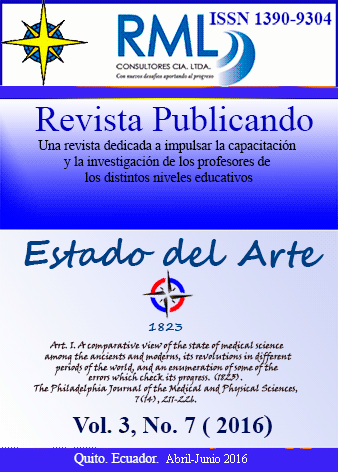Abstract
In this study the prevalence of Aspergillus spp were evaluated. (Cfu / g) and its major metabolite aflatoxin (ppb / g), corn (Zea mays L) stored in three corn silos of National Unity Storage Quevedo - Ecuador, during the first half of 2014 were sampled the west side lateral sides, the half of each silo with two replicates each sample, the samples were taken at 30, 60 and 90 days. The fungal growth was 2.06 105 4.60 105 cfu / g. The determination of aflatoxin was performed by the technique of micro Elisa, a 90 days reported the highest level of 55.71 ppb. Analysis of variance (ANOVA) was performed and means were compared with Duncan test (P <0.05). The samples returned greater than 20 ppb / g mycotoxin which is the maximum allowed by the Food and Drug Administration (FDA) and the Ecuadorian Standards Institute (INEN 187: 95) values. It is considered toxic to the corn as food for humans as well as unsafe by, for not complying with microbiological requirements of molds and yeasts than 500 cfu / g (NTE INEN 2051: 1995).
References
NTE , I. 1. (s.f.). Granos y Cereales. Maíz en Grano. Requisito. Quito.
:95, N. I. (s.f.). Norma Técnica Ecuatoriana. Granos en Almacenamiento
AESAN. (2011-2012). INFORME DEL EFECTO SOBRE LA POBLACIÓN ESPAÑOLA DE LA DEROGACIÓN DE LA NORMATIVA NACIONAL SOBRE LÍMITES MÁXIMOS PERMITIDOS PARA LA AFLATOXINAS B1, B2, G1 Y G2 EN ALIMENTOS. Comité Científico n°14.
Bauzá, R. (2007). http://www.gidesporc.com.ar. Recuperado el 09 de 04 de 2013
Coromoto Chavarri, M., Mazzani Cardinalis, C. B., Luzón, O., & Garrido, M. J. (2012). Detección de hongos toxigénicos en harina de maíz precocidas distribuidas en el estado de Aragua.Venezuela. Sociedad Venezolana de Microbiología , 126-130.
De Oliviera, L., Marfins, G., Braghini, R., Kobashigawa, E., & Correa, B. (2011a). Characterization of aflatoxigenic and non aflatoxigenic strains of Aspergillus section Flaviisolates from com grains of different geographic origins in Brazil.Eur J. plant phatol. Brazil.
De Oliviera, L.; Marfins, G.; Braghini, R.; Kobashigawa, E.; Correa, B.;. (2011b). Characterization of aflatoxigenic and non aflatoxigenic strains of Aspergillus section Flaviisolates from com grains of different geographic origins in Brazil.Eur J. plant phatol. Brazil.
Heras Salguero, A. (2009). Separación de micotoxinas mediante cromatografía de líquidos de ultrapresión acoplada a espectrometría de masas en tándem. Universidad Almería.
Hernández Delgado, S., Reyes López, M. A., García Olivares, J. G., Mayek Pérez, N., & Reyes Méndez, C. A. (2007). INCIDENCIA DE HONGOS POTENCIALMENTE TOXÍGENOS EN MAÍZ (Zea mays L.) ALMACENADO Y CULTIVADO EN EL NORTE DE TAMAULIPAS, MÉXICO. Revista Mexicana de Fitopatología, 25(002), 127-133.
Hernández, J. R. (2009). Micotoxinas y Micotoxicosis en el Ganado Porcino . Revista Chapingo, serie Zonas Aridas, 263-269.
http://www.ecuadorinmediato.com. (4 de junio de 2010). Recuperado el 21 de septiembre de 2015, de http://ecuadorinmediato.com/index.php?module=Noticias&func=news_user_view&id=127828&umt=ecuador_tiene_suficiente_capacidad_almacenamiento_granos_ram
Kensler, Thomas ; Roebuck, Bill ; Gerald N. Wogan, Gerald; Groopman, John ;. (2010). Aflatoxine:A 50-Year Odyssey of Mechanistic and Translational. TOXICOLOGICAL SCIENCE, 1-21.
Lemus Espinoza, D., Maniscalchi Badachi, M. T., Roberto, v., De freitas, J., & Sangermano, A. (06 de 2007). http://ri.bib.udo.edu.ve/handle/123456789/1301. Recuperado el 20 de 12 de 2013
Martínez Padrón, H., Hernández Delgado, S., Reyes Méndez, C., & Vázquez Carrillo. (2013). El género Aspergillus y sus Micotoxinas en Maíz en México. Revista Mexicana de Fitopatología 31 (2), 126-146.
Martínez Ruiz, R., Rojo Martínez, G., García Gutiérrez, C., Ramírez Valverde, B., Jasso Mata, J., Nava Pérez, E., . . . Vázquez Peñate, P. (2009). Tecnologías de Granos y Semillas (1a. ed.). Sinaloa, México, México: Universidad Autónoma Indígena de México.
Mazzani, C., Luzón, O., Chavarri, M., & Alezones, J. (2006). Metodología rápida para evaluar in vitro la respuesta de genotipos de maíz a la acumulación de aflatoxinas. Fitopatol. Venez, 19(1), 1-14.
Mendoza, E. (2012). Micotoxinas. En M. C. Calvo, & E. Mendoza, Toxicología de los alimentos. México: McGrawHill.
Morales Valle, H. (2011). Mohos productores de micotoxinas. En A. J. Ramos, Micotoxinas y Micotoxicosis (pág. 20). Madrid: AMV.
Morris, L. F. (2011). Determinación de aflatoxinas en muestras de maíz (Zea mays) y arroz (Oryza sativa) para consumo humano en cinco departamento del Caribe. Recuperado el 20 de 04 de 2013, de www.bdigital.unal.edu.co/4908/1/598921.2011.pdf.
NTE INEN , 2. 1. (s.f.). Granos y Cereales. Maíz Molido, Sémola, Harina,Critz. Requisitos. Quito.
NTE INEN 187:95. (1995). Granos y Cereales. Maíz en Grano. Requisitos. Quito.
Ramos Girona, Antonio; Sanchis Almenar, Vicente; Marín Sillué, Sonia;. (2011). Haccp aplicado a las Micotoxinas. En A. Ramos Girona, Micotoxinas y Micotoxicosis (pág. 123). Madrid: A.Madrid Vicente Ediciones.
Regional, F. (10-11 de 06 de 2010). Políticas de Seguridad e Inocuidad. Chile.
Soriano del Castillo, J. M. (2007). Micotoxinas en los Alimentos. Madrid: Diaz de Santos.

This work is licensed under a Creative Commons Attribution-NonCommercial-ShareAlike 4.0 International License.
Copyright (c) 2019 Flor Marina Fon Fay Vásquez, Flor Marina Fon Fay Vásquez
